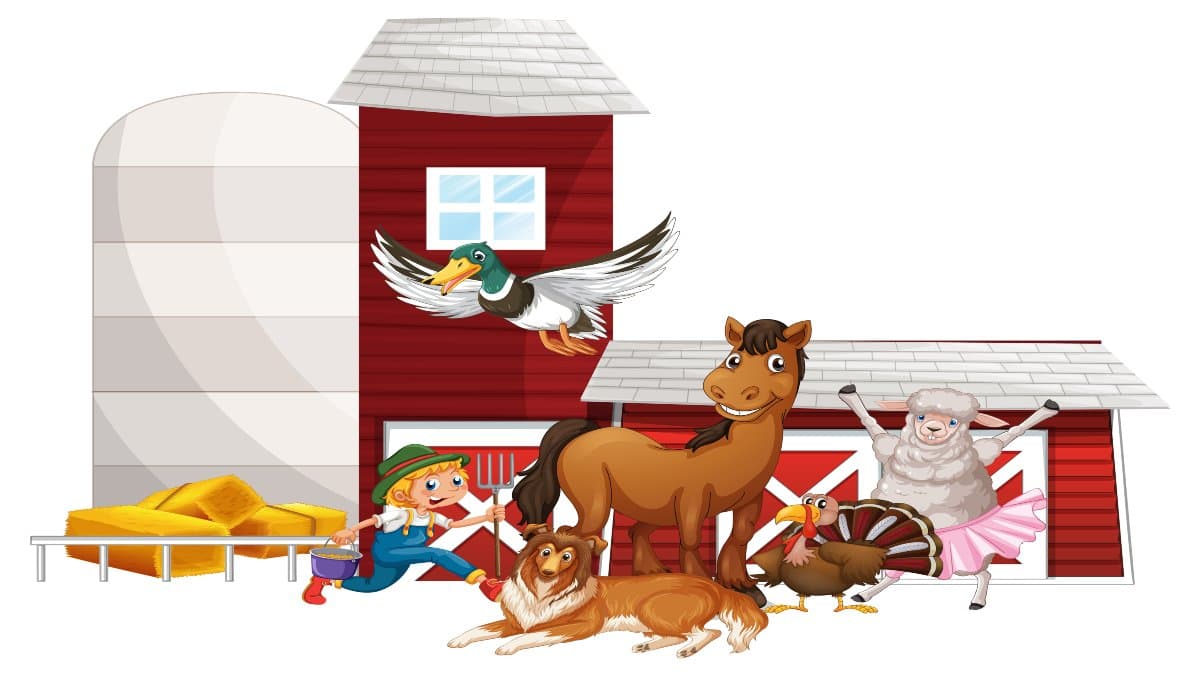Understanding Donkey Homes: From Stables to Shelters
By Pinkey Sharma |
Date 19-08-2024

Table of Contents
- What is a Donkey Home?
- What's A Donkey Home Called In English?
- Beyond the Stable: Other Types of Donkey Homes
- How to Construct a Shelter for Donkeys: Points You Should Know
- Why Should Parents and Kids Learn About Donkey Homes?
- How Donkeys Adapt to Their Homes
- What Makes a Good Home for donkeys
- Conclusion
- FAQs
Admissions Open for
Donkeys are one of those wonderful creatures who tend to get familiar to all because of their painful hard work, gentle disposition, and sheer courage. Now, where do they reside, and the form of its home is what we are going to talk about in this fascinating world of donkey home names, otherwise known as stables and shelters. We will know about various types of houses that the donkey lives in, their structure, and why it is very important for keeping donkeys secure and comfortable. It is designed for children who want to know something interesting about animals and for parents who want to teach their children something new. This blog will be fun for children.
While explaining the details, first look at very easy question:
What is a Donkey Home?
The most common Donkey Home name or their living place is called a stable. However, donkeys may live in other types of shelters. The word "stable" is used in English to refer to a home not only for donkeys but also horses and other livestock.
What's A Donkey Home Called In English?
So, when you're talking about a donkey’s home name in English, you're usually talking about a stable. However, you can keep donkeys in a barn, a run-in shed, or even just outdoors with a small shelter. In view of their differences in design, all these homes have one and the same goal: the protection of the donkeys and making sure that they are comfortable and healthy.
Also Read: Animals and their homes
The Classic Donkey Home: The Stable
A stable is the most common type of home for a donkey. But what makes a stable the perfect donkey home name? Let's take a closer look.
1. Weather Protected: First of all, it protects it from the bad weather. Whether it rains or snows, or it is extremely hot, a stable offers a warm and comfortable space inside, where the donkey can stay dry. The walls and the roof of the stable work as a shield against wind, rain, and sun so that the donkey may be comfortable in any kind of weather.
2. Moving Space: A good stable is not small in size; rather, it is one in which the donkey has space to stand up, move forward, lie down, and stretch. Donkeys are active animals and, as such, need some space to be comfortable. How happy and healthy a donkey is will be made or broken by the size of the stable itself.
3. Comfortable Bedding: Most stables have soft bedding, such as straw or hay, for the floor. This bedding will provide the donkey with a warm, comfortable lying space and help keep the stable clean. Nevertheless, bedding must be changed regularly to prevent the build-up of dirty and unpleasant odors within the stable.
4. Food and Water: A stable is also a place to store food and water for a donkey. A donkey needs fresh water and good, healthy food—like hay, grass, and sometimes special pellets—every day. That food and water in its home make it possible for the donkey to feed and drink any time it wants, so it remains healthy and becomes strong.
Beyond the Stable: Other Types of Donkey Homes
A stable is the most common name for a donkey's house. However, all these other options have their specific benefits and help keep the donkey safe and happy.
1. Run-In Sheds
This open-sided run-in shed is a very simple type of shelter, yet allows the donkey to move in and out freely. This kind of donkey home name works best for those who would like their animals to spend their time staying outside but sometimes would like to get some shade or seek protection from the changing weather. Donkeys Love Run-In Sheds. By nature, donkeys are both curious and moving creatures. They exercise their will to move around and to investigate things. A run-in shed lets them enjoy two worlds: they can step in if they want to hide, and they are also free to move as they wish
2. Barns
Another large building is a barn, which houses several kinds of animals, including donkeys. Donkeys can be kept in a special partition of their own, alone or in a group, inside a barn, along with other animals. If a donkey lives on a farm with other animals, a barn might be the best donkey home name.
How to Construct a Shelter for Donkeys: Points You Should Know
Building a home for a donkey requires planning and deliberation. One might build a stable, a shed, or a shelter, all meant to attain the same objective: serving the needs of the donkey.
1. Location
The first thing in building a donkey home is to select the right site. The location of the home should be in a safe place, totally dry, and accessible. Also, you should ensure that the ground surrounding the home is well-drained to avoid piling of water, which may lead to mud or puddles.
2. Designing the Home
That will depend on the kind of shelter one is designing: a stable will naturally have a wall, a roof, and a door to enclose it, while a shed may have only three walls and a roof. Whichever way one decides to design it, the house will have to be airy, thus giving the donkey an allowance to move around it freely yet be protected from the weather changes.
3. Bedding and Provision of Essentials
Upon setting up the home of the donkey, provide bedding, food, and water. Straw or hay may work well as bedding. Being soft and warm to the feel, it is very essential to keep clean and replace it often. In the donkey house, fresh water and food should be set forth so as to make the donkey a very healthy one.
4. Maintenance
One of the requirements for adequate care of the donkey's environment is regular maintenance. Their bedding is supposed to be replaced, structural damage should be examined, food and water should always be fresh. Regular maintenance provides safety, health, and comfort for the donkey in terms of its environment.
5. A Clean home
Although donkeys can often be particular about where they live, they do need clean comfortable homes. They are social animals; they just like to know that there is someone else there to hang out with. It's always good to have more than one donkey because they love to share a barn or shelter, and it's good security to know they have another living thing in their space.
6. Donkeys and their Pastures
Though donkeys are great explorers of pastures, they do like to have a shelter available; it seems to give them a feeling of security, knowing if the weather turns inclement, there's a place to retire.
Donkey home names are significant to let us know how we can better take care of such amazing animals. The stable, shed, or barn is the house of the donkey; it's one big factor to keep it fit and happy.
Why Should Parents and Kids Learn About Donkey Homes?
Learning about donkey home names is not just fun; it's also educational. By understanding what a donkey needs in its home, kids can develop a sense of responsibility and empathy for animals. Knowing exactly what the donkey needs at home is a way of building children's sense of responsibility and compassion toward the donkey. Using such learning processes, parents will be able to teach their children how to care for pets and livestock, benefiting the entire family.
How Donkeys Adapt to Their Homes
One of the wonders of asses is their adaptability to a new habitation. A donkey will be comfortable in a stable, shed, or pasture in a very short time. It will know the areas of food and rest as well as how to stay safe within the general environment.
Donkeys are intelligent animals; they know the location of their home almost instantly. This contributes to a feeling of security, whether it be in a stable or a pasture.
Just as humans are sure to have their own feelings about a home, donkeys will have preferences. Some probably would want a really nice, tightly enclosed stable, whereas others like the freedom that comes with a good run-in shed. Understanding these would help us build them a perfect place.
What Makes a Good Home for donkeys
A well designed, constructed home is a necessity in good health for a donkey to be found. It provides a home to a donkey where it can rest, eat and sleep thus providing a safe space. A good donkey home provides protection to the donkey from illness or injury and hence is a core component in its care.
Designing a perfect home involves meeting the requirements of donkeys and providing the necessary space according to their requirements. These may be in many forms, including a stable, a shed, or even a pasture shelter, so long as the ultimate goal is in the making of any of these—an abode that is secure, comfortable, and safe for a donkey.
Conclusion
A donkey is a very faithful animal; it really works hard and truly deserves the best home that we can give them. Whether in a stable, shed, or a barn, every single model of a donkey home plays an important role in keeping such animals safe and happy. Understanding what makes a good donkey home will ensure that every donkey has a place where it feels comfortable and taken care of.
Now, the next time anybody asks you, "What is a donkey's home name?", you would be able to not only answer the question but be aware of ways to provide that beautiful home for them. A donkey home is far more than just a mere shelter for the animal; in actual logic, a place to live for donkeys.
FAQs
1 What is a donkey shelter?
Donkey shelters provide a safe space where they can seek refuge and stay comfortable. These social beings thrive on companionship. Shelters offer opportunities for them to interact with other donkeys, fostering emotional well-being and reducing loneliness.
2. What do donkeys need for shelter?
Sheltering sheds can vary in size and shape but a regular three sided, roofed shed is ideal. Key features of the shed are height – around 2m high is sufficient, width – it needs to be wide enough to take at least two donkeys comfortably, and safety – ensuring there is nothing they can hurt themselves on.
3. What is a female donkey called?
A female donkey is called a jennet or jenny. When a female horse and a male donkey mate, the resulting offspring is called a 'mule'. When a male horse and a female donkey mate, the offspring is called a 'hinny'. When a male zebra and a female donkey mate the offspring is called a 'zedonk' or 'zebrass'.
4. What to feed donkeys?
In the majority of cases this should be solely provided by straw, hay/haylage or restricted grazing plus a vitamin and mineral balancer. If your donkey has no dental problems, feed a diet of 75% straw in summer and 50% straw in winter. Make up the remainder of their diet with hay or haylage, or restricted grazing.
5. What are some facts about donkeys?
Donkeys are not like horses; they differ physically, mentally and emotionally. Donkeys are more stoical in their behavior and tend to startle less than horses. Compared to horses, donkeys show limited fear response to novel situations and this can be mistaken for stubbornness rather than fear.
If you enjoyed learning about donkey homes and want to share this knowledge with others, feel free to share this blog with your friends and family!
Related Blog
Tiger Home Name: Exploring Tiger Homes. What Are the Names and Significance?
CBSE Schools In Popular Cities
- CBSE Schools in Bangalore
- CBSE Schools in Mumbai
- CBSE Schools in Pune
- CBSE Schools in Hyderabad
- CBSE Schools in Chennai
- CBSE Schools in Gurgaon
- CBSE Schools in Kolkata
- CBSE Schools in Indore
- CBSE Schools in Sonipat
- CBSE Schools in Delhi
- CBSE Schools in Rohtak
- CBSE Schools in Bhopal
- CBSE Schools in Aurangabad
- CBSE Schools in Jabalpur
- CBSE Schools in Jaipur
- CBSE Schools in Jodhpur
- CBSE Schools in Nagpur
- CBSE Schools in Ahmednagar
- CBSE School In Tumkur

Call Us to know more about Orchids
Swipe Up

.jpg&w=1920&q=80)














